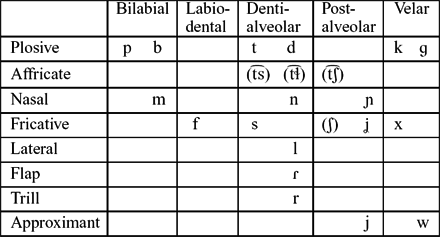Spanish is a Romance language spoken by approximately 405,638,110 speakers in the world (Lewis, Simons & Fenning Reference Lewis, Simons and Fennig2013). Two major varieties are distinguished, Peninsular Spanish (Spain) and the Spanish spoken in the Americas, although it is also spoken natively in some parts of Africa, and in the United States. Spanish in the Americas comprises several dialects well differentiated by variations in the lexicon, phonology and, more importantly, in intonational patterns. In Mexico 86,211,000 (88% of the population) use Spanish as their first language, and a significant number of indigenous people have Spanish as their second language. The variety illustrated here is representative of the speech of the educated middle-class population from the metropolitan zone (three female and three male speakers in their 30s), which has as its center Mexico City, the most densely populated urban area in the country with more than 20 million people according to the Mexican National Census (INEGI 2010).
Consonants
The consonant inventory of Mexico City Spanish is presented in the chart below. The consonants in parentheses occur primarily in loanwords.
Plosives /t/ and /d/ are typically dento-alveolar whereas the rest of the coronals, /n s l ɾ r/, are generally alveolar. Voiceless plosives are characterized by a very short VOT: /p/ = 15 ms, /t/ = 20 ms, /k/ = 49 ms, whereas voiced plosives have rather long negative VOT values: /b/ = –65 ms, /d/ = –84 ms, /ɡ/ = –73 ms (mean values from three females, and three males speakers, n = 100 tokens per consonant). Glottal stop is non-phonemic in Spanish but it can be inserted as onset to onsetless syllables (as in e.g. [ʔel ![]() jaˈxeɾo] ‘the traveler’ in the transcribed passage below). As in other varieties of Spanish, in Mexico City Spanish one of the main allophonic variations of the voiced series is lenition in intervocalic environments; other contexts in which lenition can occur include word-final position or after a vowel and before a liquid. In Mexico City Spanish the allophones range from fricatives to approximants ([β] ~ [
jaˈxeɾo] ‘the traveler’ in the transcribed passage below). As in other varieties of Spanish, in Mexico City Spanish one of the main allophonic variations of the voiced series is lenition in intervocalic environments; other contexts in which lenition can occur include word-final position or after a vowel and before a liquid. In Mexico City Spanish the allophones range from fricatives to approximants ([β] ~ [![]() ], [ð] ~ [
], [ð] ~ [![]() ], [ɣ] ~ [
], [ɣ] ~ [![]() ]) as in [ˈaβa] ~ [ˈa
]) as in [ˈaβa] ~ [ˈa![]() a] ‘broad bean’, [ˈaða] ~ [ˈa
a] ‘broad bean’, [ˈaða] ~ [ˈa![]() a] ‘fairy’, [ˈaɣa] ~ [ˈa
a] ‘fairy’, [ˈaɣa] ~ [ˈa![]() a] ‘does (subjunctive)’. Phonological voiced plosives have allophones that range from plosives to approximants when preceded by /ɾ/, /l/ or /s/, as in [ˈaɾbol] ~ [ˈaɾ
a] ‘does (subjunctive)’. Phonological voiced plosives have allophones that range from plosives to approximants when preceded by /ɾ/, /l/ or /s/, as in [ˈaɾbol] ~ [ˈaɾ![]() ol] ‘tree’, [ˈalba] ~ [ˈal
ol] ‘tree’, [ˈalba] ~ [ˈal![]() a] ‘morning’, [ˈaɾda] ~ [ˈaɾ
a] ‘morning’, [ˈaɾda] ~ [ˈaɾ![]() a] ‘it burns (subjunctive)’, [ˈkaldo] ~ [ˈkaldo] ‘broth’, [ˈkaɾɡa] ~ [ˈkaɾ
a] ‘it burns (subjunctive)’, [ˈkaldo] ~ [ˈkaldo] ‘broth’, [ˈkaɾɡa] ~ [ˈkaɾ![]() a] ‘load’, [ˈalɡa] ~ [ˈal
a] ‘load’, [ˈalɡa] ~ [ˈal![]() a] ‘sea-weed’. Approximants are found usually in informal and faster speech rates, whereas fricatives and plosives are more common in citation forms.
a] ‘sea-weed’. Approximants are found usually in informal and faster speech rates, whereas fricatives and plosives are more common in citation forms.
Mexico City Spanish has three phonemic nasals, /m n ɲ/. Clusters involving nasals as the first member are always homorganic, [impoˈsible] ‘impossible’, [ˈmaŋɡo] ‘mango fruit’, [iɱfeˈlis] ‘unhappy’, [iɲ![]() ekˈsjon] ‘injection’. Place assimilation may occur across words provided that no pause is made in between the nasal and the following consonant (see [taɱˈfwerte] ‘as strong as’ in the transcribed passage below). The palatal nasal occurs mainly in intervocalic position. However, some innovative words of Mexico City Spanish, such as [ˈɲaɲaɾa] ‘tickle’, [ˈɲeɾo] ‘buddy’ or [ˈɲoɲo] ‘silly’, show that the phonotactics of the language allows word-initial palatal nasals.
ekˈsjon] ‘injection’. Place assimilation may occur across words provided that no pause is made in between the nasal and the following consonant (see [taɱˈfwerte] ‘as strong as’ in the transcribed passage below). The palatal nasal occurs mainly in intervocalic position. However, some innovative words of Mexico City Spanish, such as [ˈɲaɲaɾa] ‘tickle’, [ˈɲeɾo] ‘buddy’ or [ˈɲoɲo] ‘silly’, show that the phonotactics of the language allows word-initial palatal nasals.
The lateral in Mexico City Spanish is alveolar, but varies its place of articulation to dental or alveolar according to the following segment [![]() el ˈnoɾte] ‘from the north’ and [emˈβwe
el ˈnoɾte] ‘from the north’ and [emˈβwe![]() o] ‘wrapped’. The lateral is becoming rather unstable in word-final position: it can vary between devoiced, unreleased, reduced or deleted (e.g. ‘cual de los dos’ [ˈkwa de los ˈdos] in the transcribed passage below).
o] ‘wrapped’. The lateral is becoming rather unstable in word-final position: it can vary between devoiced, unreleased, reduced or deleted (e.g. ‘cual de los dos’ [ˈkwa de los ˈdos] in the transcribed passage below).
Spanish has a phonemic contrast between a flap and a trill, /ɾ/ ~ /r/. The distribution of this pair is defective in the sense that the flap occurs intervocalically, word-finally, and in consonant clusters (plosive–flap), whereas the trill occurs word-initially and intervocalically (see Harris Reference Harris1969 for phonological analysis). There is a previously undescribed realization of the trill in the speech of some speakers of Mexico City Spanish. The most salient observation indicates that the trill is also realized as a voiced retroflex fricative [ʐ], especially noticeable in the speech of middle-class female speakers. Such pronunciation was also found in the speech of some the speakers included in this illustration. Figure 1 includes the sound pressure oscillograms and corresponding spectrograms illustrating the variation of the phonemic trill in two female speakers (f2 and f3).
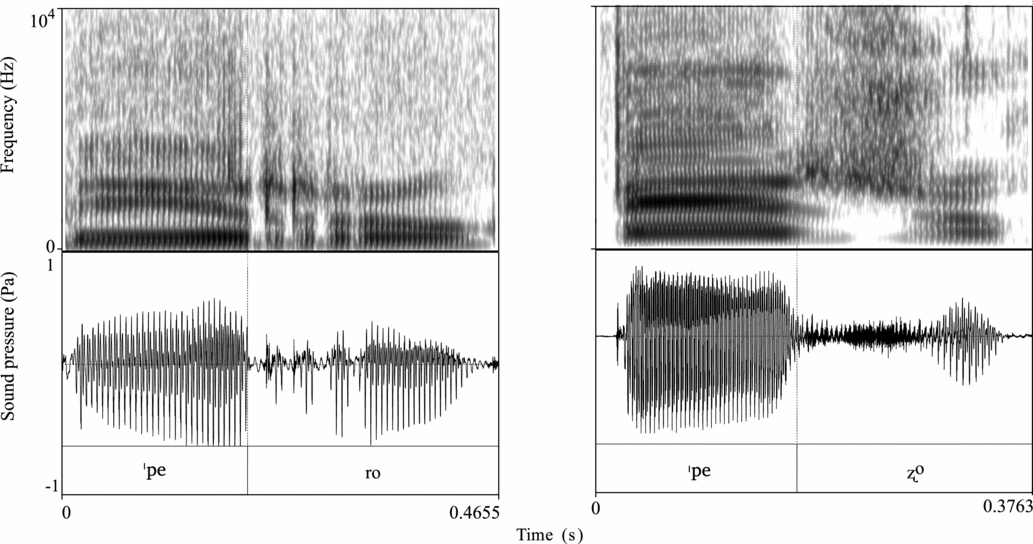
Figure 1 Spectrograms and waveform of words illustrating the realization of /r/ as [r] and [ʐ] in the word perro ‘dog’ in the speech of two female speakers (f2) and (f3). The left panel shows the trill and the right panel shows the fricative pronunciation.
One of the main differences between Peninsular Spanish and the Spanish spoken in the Americas is the absence of [θ] in the latter. The corresponding sound is pronounced as [s] in Mexico City Spanish. Frequently, [s] is fully or, more often, partially voiced before voiced consonants [ˈizla] ‘island’, [ˈazma] ‘asthma’, [ˈsizne] ‘swan’, [izraˈel] ‘Israel’, [ezˈboso] ‘sketch’, [ˈdezde] ‘from’, [ˈmuz![]() o] ‘mold’. Mexico City Spanish has a velar fricative [x] rather than glottal or uvular [h] or [χ], which occur in other varieties. The production of the palatal fricative /ʝ/ varies in a continuum from an approximant to a fricative to an affricate, [j] ~ [ʝ] ~ [
o] ‘mold’. Mexico City Spanish has a velar fricative [x] rather than glottal or uvular [h] or [χ], which occur in other varieties. The production of the palatal fricative /ʝ/ varies in a continuum from an approximant to a fricative to an affricate, [j] ~ [ʝ] ~ [![]() ]. The variation depends on individual, stylistic and even lexical factors such a word frequency. The approximant is frequently found in fast speech, as well as in some words written with hi, like in hiedra ‘ivy’, hiel ‘bile’, hierro ‘iron’. However, some words like yelmo ‘helmet’ and yerro ‘I wander (accidentally from a fixed or chosen route)’ are pronounced mainly as affricates. The affricate allophone tends to occur word-initially, as in [ˈ
]. The variation depends on individual, stylistic and even lexical factors such a word frequency. The approximant is frequently found in fast speech, as well as in some words written with hi, like in hiedra ‘ivy’, hiel ‘bile’, hierro ‘iron’. However, some words like yelmo ‘helmet’ and yerro ‘I wander (accidentally from a fixed or chosen route)’ are pronounced mainly as affricates. The affricate allophone tends to occur word-initially, as in [ˈ![]() eno] ‘full’, and after sonorants, as in [ˈkoɲ
eno] ‘full’, and after sonorants, as in [ˈkoɲ![]() uxe] ‘spouse’. The fricative and the approximant are equally common between vowels [ˈkaʝe] ~ [ˈkaje] ‘street’.
uxe] ‘spouse’. The fricative and the approximant are equally common between vowels [ˈkaʝe] ~ [ˈkaje] ‘street’.
Influence from American Indian languages
Mexico City Spanish has been influenced by contact with native languages of the Americas for more than five centuries. In the case of the variety spoken in Mexico City the most notable influence comes from Nahuatl, the language spoken by the Aztecs, and still the indigenous language with most native speakers in Mexico. The Nahuatl substrate introduced sounds such as the voiceless palatal fricative [ʃ], the voiceless alveolar affricate [![]() ] and the voiceless alveolar lateral affricate [
] and the voiceless alveolar lateral affricate [![]() ] into Mexico City Spanish. Illustrations of these sounds are shown below with spectrograms of [ˈʃola] ‘Xola (name of a street and neighborhood in Mexico City)’, [ˌaskapoˈ
] into Mexico City Spanish. Illustrations of these sounds are shown below with spectrograms of [ˈʃola] ‘Xola (name of a street and neighborhood in Mexico City)’, [ˌaskapoˈ![]() alko] ‘Azcapotzalco (name of a neighborhood)’ and [ˌpopokaˈtepe
alko] ‘Azcapotzalco (name of a neighborhood)’ and [ˌpopokaˈtepe![]() ] ‘Popocatepetl (name of a volcano)’, in Figures 2, 3 and 4, respectively. As a result of this influence, words with a lateral affricate are quite common in Mexico City Spanish, while in other Spanish dialects they are limited to a few words or completely absent. Yet, the adaptation into Mexico City Spanish loan words containing [ʃ] and [
] ‘Popocatepetl (name of a volcano)’, in Figures 2, 3 and 4, respectively. As a result of this influence, words with a lateral affricate are quite common in Mexico City Spanish, while in other Spanish dialects they are limited to a few words or completely absent. Yet, the adaptation into Mexico City Spanish loan words containing [ʃ] and [![]() ] is subject to a wide range of variation, while [
] is subject to a wide range of variation, while [![]() ] is rather stable. Thus, for instance, [ʃ] is also pronounced as [
] is rather stable. Thus, for instance, [ʃ] is also pronounced as [![]() ], [
], [![]() ] occurs mainly in coda position, while a [
] occurs mainly in coda position, while a [![]() ] one occurs mainly in onset position.
] one occurs mainly in onset position.
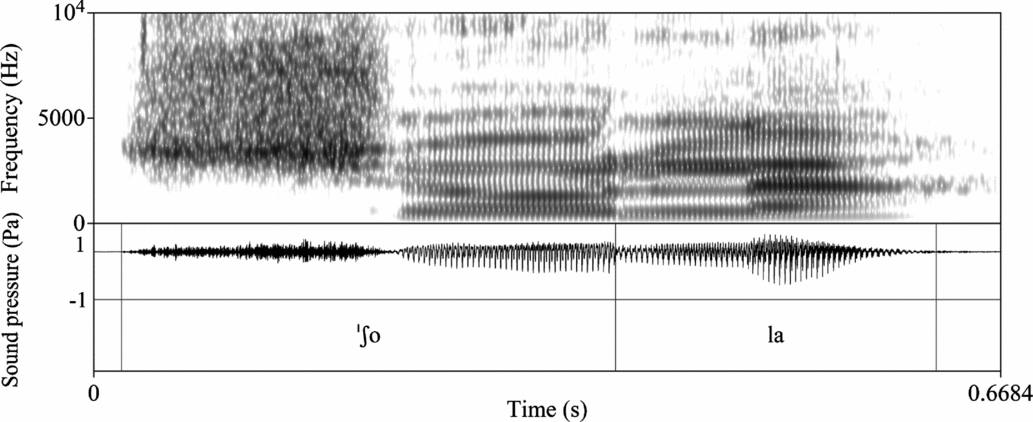
Figure 2 Illustration of the borrowed sound /ʃ/ from Nahuatl in Mexico City Spanish with the word [ˈʃola].
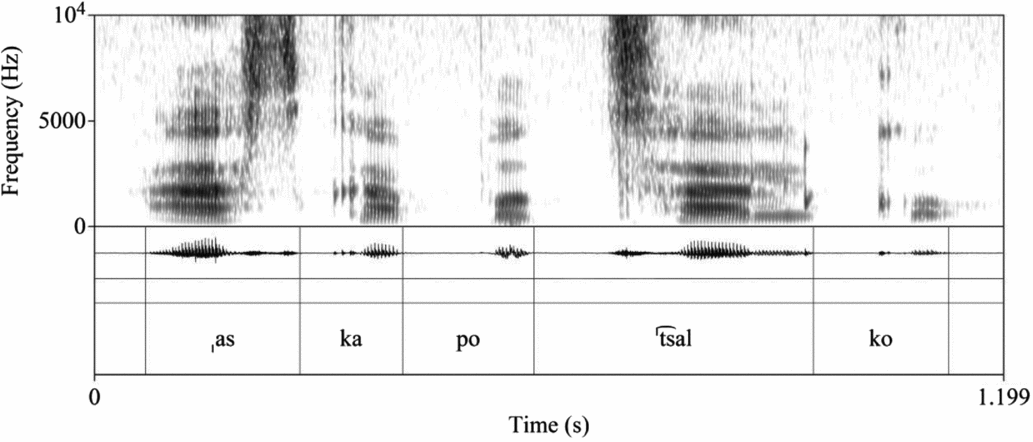
Figure 3 Illustration of the borrowed sound /![]() / from Nahuatl into Mexico City Spanish with the word [ˌaskapoˈ
/ from Nahuatl into Mexico City Spanish with the word [ˌaskapoˈ![]() alko].
alko].
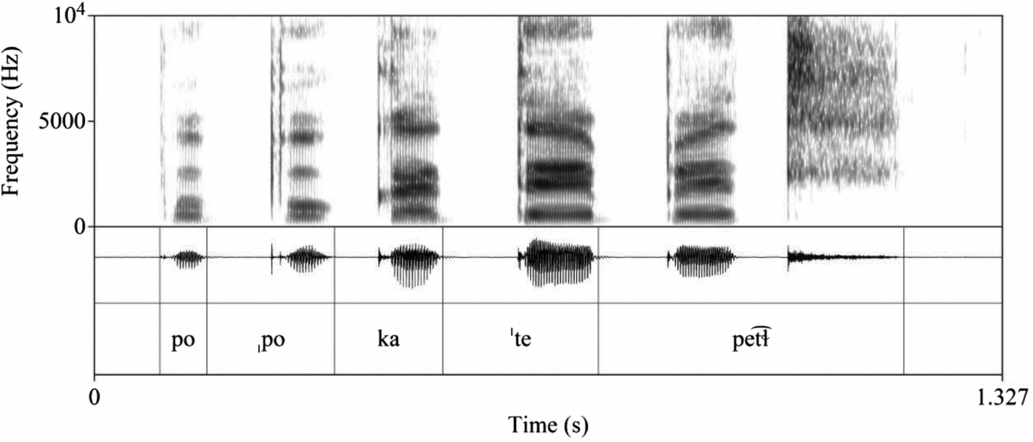
Figure 4 Illustration of the borrowed sound /![]() / from Nahuatl in Mexico City Spanish with the word [ˌpopokaˈtepe
/ from Nahuatl in Mexico City Spanish with the word [ˌpopokaˈtepe![]() ].
].
Vowels
Spanish has a five-vowel system /a e i o u/. The distribution of the vowels in the acoustic space is typical of a five-vowel system, with the front vowels having a higher position, i.e. lower values of F1. Figure 5 shows the mean values of female and male vowels. The five vowels can appear in both stressed and unstressed positions; /i/ and /u/ can be realized as close vowels in unstressed positions. Overall, stressed vowels are typically longer than unstressed ones. There is a tendency to use more open pronunciations of vowels in closed syllables.
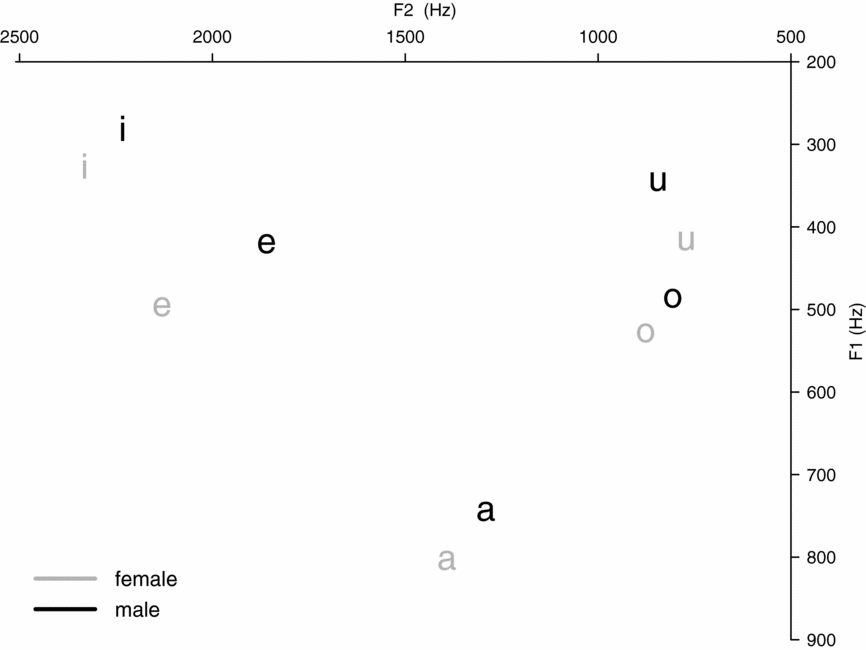
Figure 5 Mean formant values of female (faint symbols) and male vowels (solid symbols).
Diphthongs are formed with [![]() ] or [
] or [![]() ] as offglides in combination with any of the other vowels (excepting for the sequences u
] as offglides in combination with any of the other vowels (excepting for the sequences u![]() , i
, i![]() ) /a
) /a![]() a
a![]() e
e![]() e
e![]() o
o![]() /. In Mexico City Spanish, as in other varieties (Chitoran & Hualde Reference Chitoran and Hualde2007), some words show alternation between a diphthongal pronunciation and vowel hiatus, e.g. [ˈpja.no] versus [pi.ˈa.no] ‘piano’. However, there are lexical restrictions to the alternation, as pairs of words with diphtong ot hiatus may contrast as in hoy ‘today’ and oí ‘I heard’. In running speech, diphthongs may also be formed with a mid glide, [
/. In Mexico City Spanish, as in other varieties (Chitoran & Hualde Reference Chitoran and Hualde2007), some words show alternation between a diphthongal pronunciation and vowel hiatus, e.g. [ˈpja.no] versus [pi.ˈa.no] ‘piano’. However, there are lexical restrictions to the alternation, as pairs of words with diphtong ot hiatus may contrast as in hoy ‘today’ and oí ‘I heard’. In running speech, diphthongs may also be formed with a mid glide, [![]() ] or [
] or [![]() ], as in óleo ‘oil painting’ or poeta ‘poet’.
], as in óleo ‘oil painting’ or poeta ‘poet’.
Final lenition, expressed as the reduction and even deletion of unstressed vowels in syllables final within the scope of an intonational phrase, is typical of Mexico City Spanish. Words like [ˈfweɾt
] ‘strong’, [po
eˈɾos
] ‘powerful’, [i
ˈtensaˌme
t] (spelled out as intensamente) ‘intensely’ are examples observed in the transcribed passage below. The following examples illustrate the typical variation in lenition ranging from vowel shortening to vowel devoicing and vowel deletion as the most extreme case:
Stress and intonation
Spanish stress is contrastive and can fall on any of the three last three syllables of a word. Penultimate stress is the most frequent pattern; however, stress occurs in the pre-antepenultimate syllable in verbs containing proclitic forms (such as in imperative forms) [reˈ![]() alaˌselo] ‘give it to her!’. Figure 6 shows the spectrogram, intensity curve, f0 contour and sound pressure oscillogram of a triple contrast of stress. As the figure shows, there is no single acoustic cue that can signal stress alone, but the prominence of the stressed syllable is achieved by the three acoustic properties together (see Ortega-Llebaria & Prieto Reference Ortga-Llebaria and Prieto2011 for stress in Catalan and Castillian Spanish.)
alaˌselo] ‘give it to her!’. Figure 6 shows the spectrogram, intensity curve, f0 contour and sound pressure oscillogram of a triple contrast of stress. As the figure shows, there is no single acoustic cue that can signal stress alone, but the prominence of the stressed syllable is achieved by the three acoustic properties together (see Ortega-Llebaria & Prieto Reference Ortga-Llebaria and Prieto2011 for stress in Catalan and Castillian Spanish.)
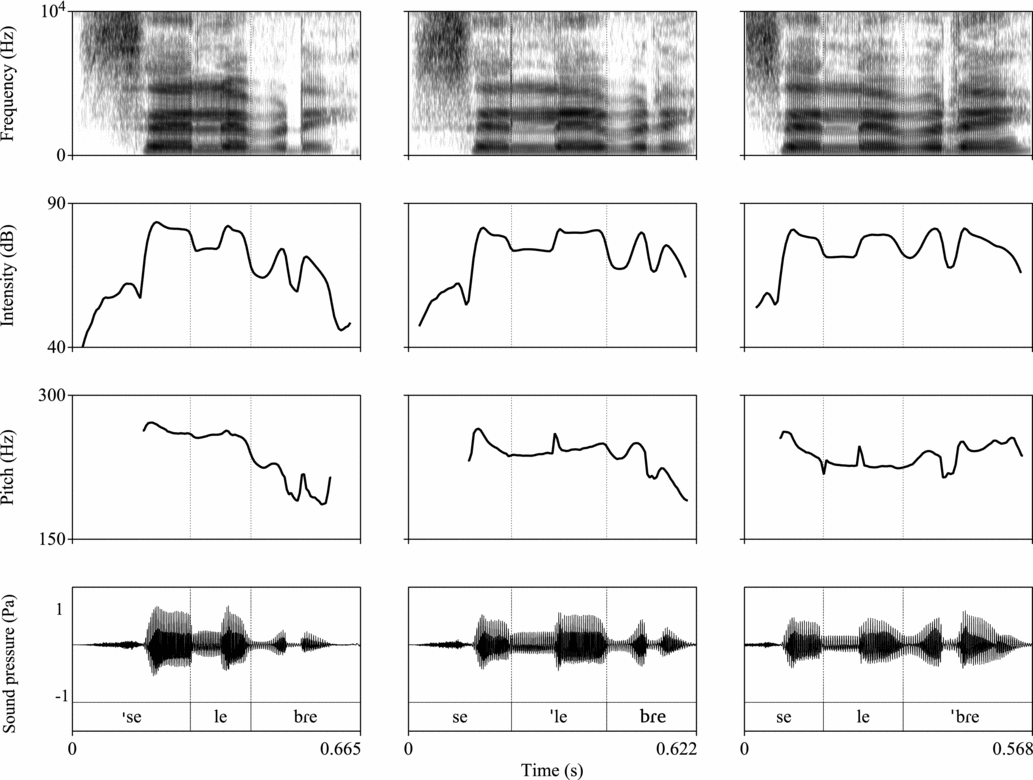
Figure 6 Spectrogram, intensity curve, pitch track, and sound pressure wave form of the triplet [ˈselebɾe] ‘celebrated’, [seˈlebɾe] ‘he celebrates (subjunctive)’, and [seleˈbɾe] ‘I celebrated’ illustrating the stress contrast in Mexico City Spanish.
There are two major intonational patterns of declarative sentences in Mexico City Spanish. One is similar to that of varieties described in earlier studies (Navarro Tomás Reference Navarro Tomás1944, De la Mota et al. Reference De la Mota, Butragueño, Prieto, Prieto and Roseano2010) in that the f0 peak of a pitch accent is shifted from the stressed syllable to the following syllables. The other intonational pattern is emblematic of the working class speech variety of Mexico City Spanish, where the peak of the pitch accent is aligned with the stressed syllable (see Prieto, van Santen & Hirschberg Reference Prieto, van Santen and Hirschberg1995, Kim & Avelino Reference Kim, Avelino, Herrera and Butragueño2003).
Transcribed passage
Orthographic version
El viento del norte y el sol estaban discutiendo sobre cuál de los dos era el más fuerte, cuando pasó un viajero envuelto en una gruesa capa. Quedaron de acuerdo en que quien primero lograra que el viajero se quitara la capa sería considerado el más poderoso. Entonces, el viento del norte sopló tan fuerte como pudo, pero entre más soplaba, más se cobijaba en su capa el viajero; al fin el viento del norte se rindió. Entonces el sol brilló intensamente, e inmediatamente el viajero se quitó la capa. Así, el viento del norte se vio obligado a reconocer que el sol era el más poderoso de los dos.
Narrow transcription
Acknowledgements
I am grateful to Juana Gil Fernández, Ascensión Hernández Triviño y Claudia Parodi for their comments and suggestions. Special thanks to Adrian Simpson, Amala Arvaniti and Ewa Jaworska for editorial guidance. I acknowledge the anonymous reviewers for their opportune comments. Finally, many thanks to the speakers who volunteered to record their voices for this illustration. I am solely responsible for the contents of this article.
This research was carried out while the author was at the Department of Linguistics, University of California, Berkeley.


